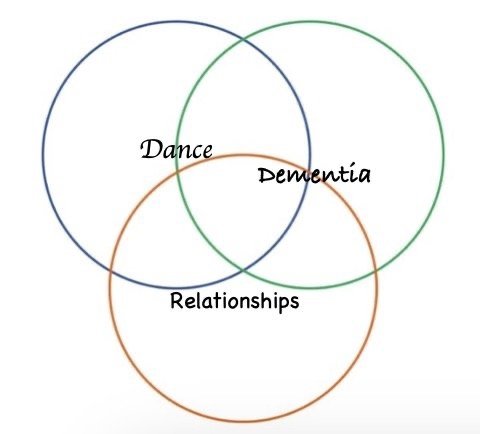Learn to Bring Dance to People with Dementia
My life's work as a dance/movement therapist has been about "seeing" what is invisible to the eye. The Octaband®, which I created, makes visible the space between us ~ the heart space. It is enormously powerful as people see their connection to one another -- especially people with dementia who live in residences and so often feel isolated and abandoned, and even more so those who are no longer verbal. The fact that they can't speak does not mean that they don't know what's going on around them. They flourish when they feel connected.
My trainings to bring dance to people with dementia teach us how to see and understand the space between people through the interface of three topics: dance, dementia, and relationships.
Perhaps you wonder why you might want to take my upcoming training, June 1 and 2 in Dedham, MA.
With all due humility, 45 years of experience has given me a lot of opportunities for trial and error. I believe I have found ingredients that make for a successful group, whether I lead it or someone else does.
Sometimes observers say that it's just the music I play that makes it so good. I'm thoughtful about the music I play. I spend time customizing playlists, tailored for participants' ages, social and cultural backgrounds. There are over 2,000 songs on my playlists. Other people say it's just the Octaband®. No, it's actually not, but I did happen to create the Octaband because I saw the need and a solution. The need? People living with dementia, especially those who have lost words, need to feel connected. That is so important for people who often feel isolated, neglected, irrelevant. Without each person, the group would not be the same. Every person contributes a bit of who they are.
In the training, we learn to see their contributions in small shifts in their engagement, which we can note and amplify so people move more and feel more alive. While a lot of training about dementia focuses on the brain, in this training, the focus is on personhood, building on people's abilities, and how we can use dance in the context of our relationship to minimize the effects of dementia. The results are extraordinary.
Tammy Center, Director of Respite Ministry, Montgomery, AL, said the dance group I led for her folks 2 months ago 'was a smashing success'" "What an AMAZING demonstration. We loved it so much." "The energy and excitement was incredible and we are and will definitely be moving more." And then, she wrote to say, "You would be so proud of our day today." That certainly makes my heart glad.
Shayndel Kahn, pictured above, took my Bring Dance training and recently shared some photos. "I just led a wonderful group this morning at an assisted living. There was a 100 year old and 110 year old! They all loved it. I loved it. I am also leading groups at another facility monthly. Thank you so much for being my teacher in this.
Yet another recent trainee reported a day after a training, "I used some of the new tools that I learned from you with my dementia client today - and I was totally blown away how they worked!!!!! . . . it all went so smoothly and well, I still can't believe it! And what almost made me cry was that in the middle of dancing she says to me "You are a really good person, you keep putting up with me even though I'm so difficult"!!!! I was so touched . . . And I remembered why I do this work. So THANK YOU for EVERYTHING - it was already more than worth it!"
Click here to learn more.
Early bird registration ends May 15. Register now.

